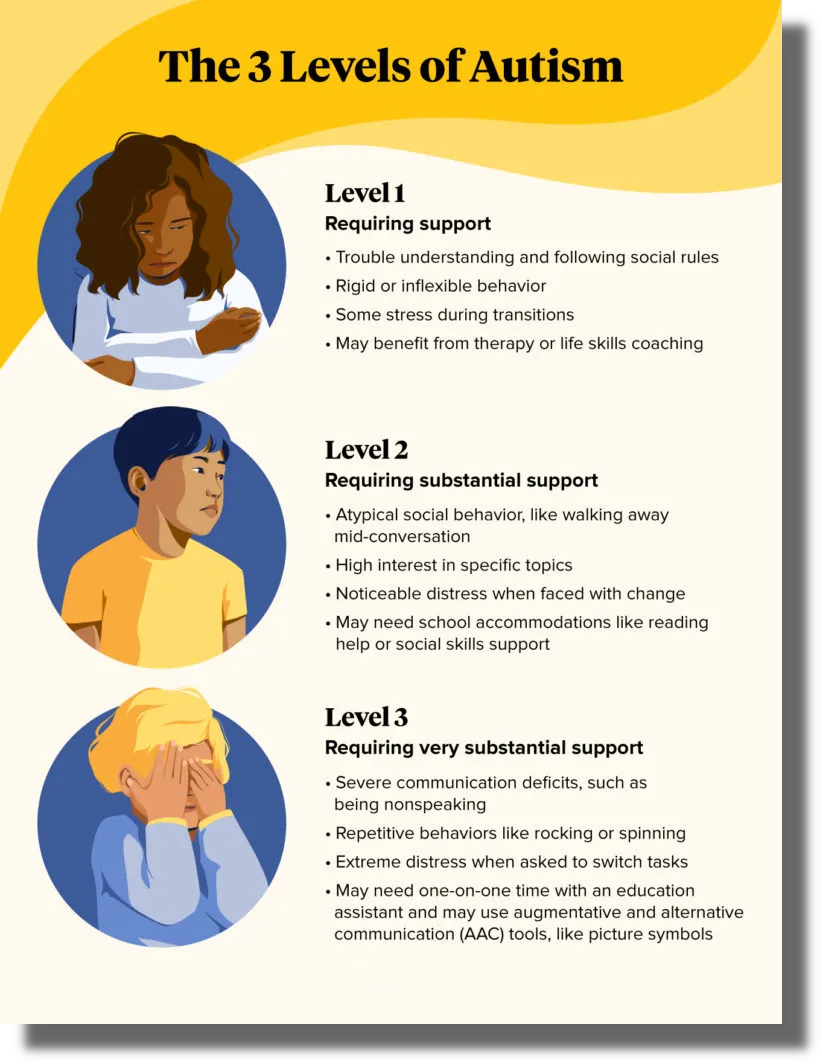Recognizing emotional signals through Autism Therapist methods
Recognizing emotional signals through Autism Therapist methods
Blog Article
Recognizing the Effect of Behavioral Autism on Life and Social Communications
You could not recognize exactly how deeply behavioral autism influences life and social interactions. Individuals on the spectrum typically navigate a world full of communication difficulties and sensory overload. These difficulties can bring about disappointment and isolation, impacting their relationships and overall well-being. Recognizing these subtleties is vital for cultivating supportive atmospheres. What strategies can we apply to develop more comprehensive areas and purposeful connections? The solutions could shock you.
Specifying Behavioral Autism and Its Characteristics
Behavioral autism, frequently described as autism range condition (ASD), incorporates a variety of problems characterized by challenges in social communication, interaction, and repetitive habits. You could notice that individuals with ASD often have a hard time to translate social signs, which can result in misunderstandings in discussions. They may locate it hard to develop eye get in touch with or take part in little talk, making social circumstances really feel frustrating.
Communication difficulties can manifest in numerous ways, from postponed speech advancement to a preference for using less words. By identifying these traits, you can cultivate an environment that advertises approval and motivates reliable interaction, aiding people with autism grow in their day-to-day communications.
The Spectrum of Autism: Understanding Irregularity in Behavior
Autism range disorder (ASD) isn't a one-size-fits-all medical diagnosis; it differs widely among people. You may experience people that are highly spoken and engage conveniently in discussions, while others might favor singular activities or connect non-verbally.
In addition, the method people with ASD respond to sensory input can differ significantly; some may be bewildered by brilliant lights or loud sounds, whereas others flourish in promoting atmospheres. The spectrum likewise includes differences in social interactions; some people might have a hard time to interpret social signs, while others navigate social settings with family member ease. Comprehending this irregularity is crucial, as it assists you value everyone's special experience and tailor assistance to their particular requirements, fostering a much more comprehensive setting for everybody.
Interaction Obstacles Faced by Individuals With Autism
When you connect with individuals on the autism spectrum, you might discover their distinct communication difficulties. They frequently face problems with both nonverbal and spoken signs, which can impact their social interactions. Understanding these obstacles is essential for fostering better connections and support.

Verbal Interaction Difficulties
Lots of individuals on the autism spectrum experience verbal communication troubles that can substantially impact their everyday communications. Your tone, pace, or quantity might not align with social assumptions, causing others to misunderstand your intentions. Identifying these difficulties can help you and your assistance network establish methods to enhance communication and promote much better links with others in your everyday life.
Nonverbal Communication Obstacles
Verbal interaction isn't the only obstacle individuals on the autism range face; nonverbal communication barriers can be equally as considerable. You might discover it challenging to interpret body movement, facial expressions, and eye get in touch with, which are important for effective interaction. These challenges can bring about misconceptions or false impressions of social cues, making communications feel overwhelming or complex. You may have a hard time to reveal your own emotions via nonverbal means, leaving others unclear of your sensations or intents. This separate can produce feelings of isolation and stress. Acknowledging these barriers is essential for cultivating understanding and compassion in your communications. By attending to nonverbal interaction, you can locate methods to improve your social experiences and boost your overall lifestyle.
Social Interaction Effects
Social communications can typically really feel overwhelming as a result of the distinct interaction challenges faced by individuals with autism. You might battle with analyzing social cues, making it difficult to comprehend mockery or body movement. This can result in misconceptions or uncomfortable moments in conversations. In addition, launching and maintaining conversations may feel challenging, causing anxiety in social scenarios. You might choose structured environments, making spontaneous communications uneasy. It's likewise common to experience problem in participating in small talk, which can prevent forming brand-new friendships. Identifying these challenges can help you find approaches to improve communication, such as exercising social abilities in safe settings or using aesthetic help - Autism Behavioral Therapy. Comprehending your requirements enables you to navigate social communications with higher confidence and simplicity.
Social Communication and Partnership Building in Autism
While building connections can be challenging for people with autism, understanding their distinct point of views and interaction designs can promote significant links. You could discover that numerous people on the spectrum choose straight interaction and may fight with social signs or small talk. By being uncomplicated in your communications, you can help develop a setting where they feel comfortable.
Involving in shared passions can also serve as a bridge to deeper links. Whether it's a hobby, a preferred program, or a common interest, these typical strings can open up doors to friendship.
Day-to-day Live Regimen: Browsing Challenges and Methods
Steering day-to-day live routines can be especially testing for people with autism, especially when unexpected modifications happen. You may locate comfort in having a structured schedule, as it assists you anticipate what's following. When disturbances Read Full Article happen, it's typical to feel overloaded or distressed. To browse these challenges, take into consideration carrying out visual routines or checklists. These devices can give clearness and peace of mind.
Establishing a regimen that consists of sensory breaks can likewise be helpful. This helps create an understanding environment.
Lastly, technique mindfulness strategies to take care of tension and anxiousness. Easy breathing workouts or basing techniques can make a significant distinction. By incorporating these approaches, you can improve your daily regimen and reduce disturbances, making life really feel much more convenient.
Strengths and Capacities of Individuals on the Autism Spectrum
Understanding life regimens is simply one aspect of the autism experience. Lots of people on the autism spectrum possess impressive staminas and capacities that set them apart. You could find that your interest to information is extraordinary, permitting you to master tasks that need accuracy and emphasis. Your ability to believe outside package can lead to cutting-edge services in different scenarios.
Furthermore, your memory abilities usually shine, particularly in locations of passion. Aba Therapist Near Me. This knack for preserving info can make you a valuable resource in fields like innovation, science, or art. You might likewise display solid visual reasoning, enabling you to picture intricate concepts and fix issues artistically
Additionally, your special point of view on the world can cultivate compassion and understanding in others, improving social interactions. Accepting these strengths not just enhances your confidence but also helps others appreciate the diverse abilities you bring to the table.
Developing Inclusive Settings for Individuals With Autism
Developing inclusive settings for individuals with autism starts with designing sensory-friendly rooms that deal with their unique demands. You can likewise foster possibilities for social communication, helping to develop connections and friendships. By making these changes, you'll contribute to an extra welcoming environment for everyone.
Designing Sensory-Friendly Spaces
While making sensory-friendly rooms, it's essential to reflect on the special needs of people with autism. Integrate quiet areas where people can pull away and charge when bewildered. Consist of visual timetables or clear signage to assist individuals navigate the space confidently.
Promoting Social Interaction Opportunities
Creating sensory-friendly rooms not only addresses private convenience however likewise establishes the stage for purposeful social interactions among individuals with autism. To promote these communications, create inclusive environments that invite participation. Organize organized tasks, like art classes or group video games, that encourage collaboration without frustrating sensory input. Use visual help and clear interaction to assist every person engage conveniently. Urge peer mentoring, combining people with autism with encouraging peers that can guide them with social scenarios. Additionally, think about holding routine area events that celebrate neurodiversity, fostering acceptance and understanding among all individuals. By executing these techniques, you can improve social opportunities, aiding people with autism construct relationships and strengthen their social skills in a secure, inviting setting.

Regularly Asked Inquiries
Just How Can Friends Assistance Somebody With Behavioral Autism?
You can support a close friend with behavior autism by holding your horses, paying attention proactively, and appreciating their borders. Take part in tasks they delight in, connect openly, and develop a comfortable environment where they really feel valued and comprehended.
What Resources Are Readily Available for Parents of Kid With Autism?
You can explore various sources for parents of youngsters with autism, including support system, instructional internet sites, and regional neighborhood solutions. Getting in touch with various other moms and dads can also give important understandings and shared experiences to help browse obstacles.
Can Behavioral Autism Change In Time?

Yes, behavioral autism can change with time. You may discover shifts in interaction, social skills, and actions as your child grows. Early treatment and assistance commonly play vital roles in these developing adjustments.
How Do Sensory Level Of Sensitivities Influence Daily Life?
Sensory sensitivities can make everyday experiences overwhelming. You might deal with review bright lights or loud noises, leading to stress or evasion. Finding environments that accommodate your requirements can significantly enhance your convenience and overall every day image source life.
What Are Common Misconceptions Regarding Behavioral Autism?
You could believe behavioral autism only affects interaction abilities, however it's more facility. Numerous assume individuals do not have compassion or intelligence, which isn't real. Understanding these misconceptions aids foster approval and support for those on the range.
Behavioral autism, typically referred to as autism spectrum disorder (ASD), encompasses a range of problems defined by obstacles in social communication, interaction, and recurring actions.Social communications can commonly feel frustrating due to the one-of-a-kind communication obstacles faced by individuals with autism.Creating sensory-friendly rooms not just addresses specific convenience however additionally establishes the phase for purposeful social communications amongst people with autism. Encourage peer mentoring, combining people with autism with helpful peers who can guide them via social situations. By applying these methods, you can boost social chances, aiding people with autism develop friendships and reinforce their social abilities in a secure, welcoming environment.
Report this page